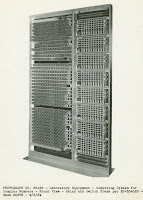In September, 1940, during a meeting of the American Mathematical Society, George Stibitz publicly demonstrated remote data processing for the first time. His "Complex Computer" at Bell Telephone's New York laboratory was able to process queries and return solutions to several problems as entered by an operator in Hanover, NH. The user in Hanover typed in the calculation to be performed on a keyboard identical to one in New York. The keystrokes made in Hanover were transmitted via telegraph to New York where they were manipulated by the computer to produce a solution. The completed solution was then transmitted back to Hanover to be printed by the remote terminal.
 |
Relay Rack for the
Complex Computer |
The "Complex Computer" was so named as it had been specifically designed to handle calculations involving complex numbers. Stibitz felt that a mechanical means of computing was not flexible enough to handle this type of problem but instead designed his device around telephone switching relays which could be "made to perform any strictly logical thinking" as the mathematics used to describe purely logical operations and those of relay circuits are the same. The one caveat to this proposed method was that all numbers would have to be translated into binary notation to simplify design as the relays themselves were standard 2-position relays. Stibitz notes in the first draft of his talk that as far as he was aware this was the "first so-called 'practical' use...of binary notation."
 |
Portion of circuit diagram
for the Complex Computer. |
Ask for ML-27, Box 1 to see Stibit'z drafts of his talk as well as blueprints and notes on the Complex Computer. The slides used in the original presentation are held in Box 53. A
guide to the collection is available.




No comments :
Post a Comment